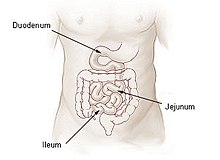Small intestine

The small intestine is between the stomach and the large intestine, and is where most of the digestion and absorption happen.[1] In humans over five years old, the small intestine is about 7.5 meters long.
The small intestine has three regions: the duodenum, the jejunum and the ileum.
- The duodenum: receives bile and juice from the pancreas, and is where most digestion in the small intestine takes place. Secretions limit, or neutralise, the stomach acidity, and enzymes help to digest the food.
- The jejenum: the products of digestion (sugars, amino acids, and fatty acids) are absorbed into the bloodstream here.
- The ileum: absorbs vitamin B12, bile salts, and any other products of digestion that were not absorbed by the jejunum.
References[change | change source]
